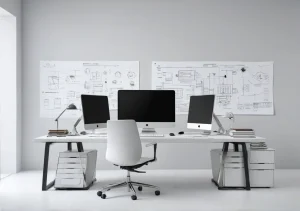Switching tech specialties often feels like you’re starting from scratch, especially when you’re staring blankly at your resume wondering, “How do I make this relevant?” Good news: You’re about to learn how to craft your story in a way that highlights your adaptability and passion for tech, no matter the specialty.
By the end of this post, you’ll know exactly how to tweak your resume to showcase your unique skills and experiences, making you an irresistible candidate for your new chosen field in technology.
Quick Takeaways:
- Tailor your resume to make transferable skills like problem-solving and project management shine for your new tech role.
- Craft a compelling objective statement that bridges your past experience with your future tech aspirations.
- Demonstrate your adaptability and capacity for growth by showcasing relevant projects and continuous learning achievements.
1. Highlight Transferable Skills
When shifting tech specialties, your resume might not scream “perfect fit” at first glance. However, the devil’s in the details—or rather, the transferable skills. Skills such as problem-solving, project management, and adaptability are gold across the tech landscape. But how do you highlight these gems?
First, take inventory of all the skills you’ve gained in your current or past role. Yes, all of them. Then, categorize these skills into technical and soft skills. For instance, if you’re moving from software development to data science, coding is a technical skill that’s transferable. Likewise, team collaboration falls under soft skills and is just as vital.
Next, tailor these skills to the job description of your target role. Noticed how a job listing emphasizes data visualization and you’ve done some of that in your previous role? Make that connection crystal clear on your resume.
Example : If your past job involved creating dashboards for tracking project milestones (even if it was just a small part of your role), elaborate on that when listing your accomplishments. It shows you have a solid foundation to build upon.
2. Tailor Your Objective Statement
The objective statement is your resume’s handshake. It’s not just a polite introduction—it’s your moment to make an impression. Crafting an objective statement that aligns with your new tech specialization demonstrates you’re not just wandering aimlessly in the tech field; you have a destination in mind.
Start with clarity and focus. Instead of a vague “Looking to leverage my background in tech,” zoom in on your new target. “Seeking to apply my extensive experience in software development to tackle challenges in cybersecurity,” for instance, bridges your past experience with your future aspirations.
Keep it concise but powerful. Employ action verbs and specify what you bring to the table and how it benefits your potential employer.
Pro-tip : Inject some personality or your unique approach to solving tech problems into your objective statement. This can set you apart from the sea of other candidates who might only be ticking off skill requirements.
3. Leverage Project Experience
When it comes to showing you’re ready to jump into a new tech specialty, nothing speaks louder than real-world experience. But if you’re thinking, “I don’t have direct experience in this new field,” fret not. It’s all about how you frame your past projects.
Choose projects that demonstrate relevant skills or learning experiences. For instance, if you’re moving into AI and machine learning, highlighting a project where you employed statistical analysis or worked with large datasets can be a good bridge.
Here’s how to present it: – Briefly describe the project goal and your role. – Highlight specific tasks you undertook that are relevant to your new specialty. Did you automate any processes? Did you analyze data to inform decision-making? These are your selling points. – Quantify your achievements where possible. Managed a project that resulted in a 20% efficiency gain? That’s music to the ears of prospective employers.
And remember, not all valuable experiences come from paid employment. Volunteer work, hackathons, and personal projects can also showcase your skills and enthusiasm for your new field.
4. Focusing on Results and Achievements
When you’re transitioning into a new tech specialty, one key strategy to make your resume shine is by zooming in on your results and achievements in previous roles. It’s not just about what you did, but how well you did it, and the impact it had. Here’s how you can ace this approach:
-
Quantify Your Achievements : Numbers talk. Did you increase website traffic by 30% through SEO optimizations? Or maybe you developed a script that saved your team 20 hours of work each month? Whatever it is, quantify it. This gives hiring managers a concrete idea of your capabilities and achievements.
-
Highlight Relevant Results : Focus on achievements that resonate with the skills and results relevant to the new specialty you’re moving into. For instance, if you’re transitioning from web development to data science, emphasize projects where you utilized data analysis or machine learning skills.
-
STAR Method : Use the Situation, Task, Action, Result method to structure your achievements. This not only highlights what you accomplished but also provides context, the challenge, the approach you took, and the outcome.
For example: – Situation: The user sign-up process was convoluted, leading to a high drop-off rate. – Task: Simplify the process to enhance user experience. – Action: Implemented a streamlined sign-up form and tested different UX designs. – Result: Achieved a 40% reduction in user drop-off and a 25% increase in sign-ups.
Remember, it’s about painting a vivid picture of how you can drive success, regardless of the tech specialty.
5. Continual Learning and Certifications
In the rapidly evolving tech landscape, showing that you’re committed to continual learning is critical, especially when you’re pivoting to a new area. Here’s how to effectively showcase your learning and certifications:
-
List Relevant Courses and Certifications : Make a section dedicated to education, courses, and certifications pertinent to the new specialty. Whether you’ve completed Google’s IT Support Professional Certificate or a Machine Learning course on Coursera, put it out there. Here’s a resource link for some of the top certification options: Coursera, Udemy, and edX.
-
Showcase Self-Taught Skills : Don’t underestimate self-taught skills. Maybe you’ve learned Python on your own, or perhaps you’ve become proficient in TensorFlow through personal projects. Mention these, making it clear that your learning initiative didn’t stop with formal education.
-
Describe How You’ve Applied Your Learning : If you’ve had the chance to apply what you’ve learned, even in a small project or volunteering opportunity, highlight this. Demonstrating the practical application of your skills is as crucial as acquiring them.
-
Stay Updated and Relevant : Tech fields evolve, so ensure the skills, tools, and certifications you list are current and in demand for your new specialty. A quick way to check this is by reviewing job listings in your desired field and noting common requirements.
Unique Insight : Create a personal GitHub repo or a portfolio website to showcase your projects, especially those that involve the new tech specialty you’re transitioning into. While many candidates list skills and certifications, having a tangible, accessible showcase of your work sets you apart. It’s like saying, “Don’t just take my word for it, take a look!” This direct proof of your capability and creativity in applying new skills can be a game-changer. Here’s a simple guide to start: GitHub Pages for hosting and Behance for creative tech portfolios.
By emphasizing your Results and Achievements and showing your commitment to Continual Learning and Certifications, you craft a narrative of a proactive, adaptable, and results-driven professional—exactly what hiring managers are looking for in candidates transitioning into new tech specialties. Remember, it’s not just about where you’ve been; it’s about where you’re capable of going and the tangible steps you’ve taken to get there. So, tailor your resume to not just recount your past, but to forecast your future success in your new tech domain.


